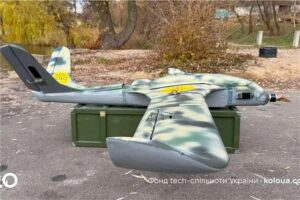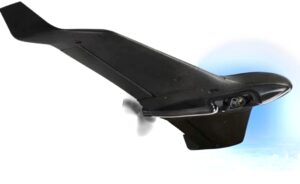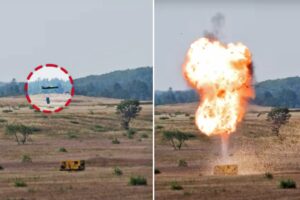The fiscal year 2025 National Defense Authorization Act (NDAA) passed this month, solidifying funding priorities and policy directives for the United States Department of Defense. And while the sweeping legislation touches nearly every corner of U.S. defense strategy, one notable absence is making waves in the technology and business worlds: the Countering CCP Drones Act was left out of the final FY25 NDAA bill.
For months, the proposed Countering CCP Drones Act generated speculation that Chinese drone manufacturers, including the market leader DJI and competitors like Autel, might face significant restrictions or an outright ban in the U.S. The act, proposed for inclusion in the final bill, sought to ban DJI drones by adding DJI to a list of companies deemed threats to national security. If that list existed, DJI’s ability to operate within certain communication spectrums crucial for drone control would be limited.
However, the omission of this provision in the final NDAA means that DJI can freely operate and sell its drones within the U.S. For drone pilots who consider DJI to be the maker of the best camera drones, that’s a relief. But for some politicians — and perhaps some other players in the drone industry including some American drone companies — it’s not all good news. Here’s what you need to know about the FY25 NDAA in terms of drones:
Omission of Countering CCP Drones Act in FY25 NDAA squashes concern about DJI drone ban
A quick history of the Countering CCP Drones Act
Representatives Elise Stefanik (R-NY) and Mike Gallagher (R-WI) first introduced the Countering CCP Drones Act in the House in April 2023. That bill then was included in the proposed version National Defense Authorization Act (NDAA) for Fiscal Year 2025. Inclusion in that proposal was good news for supports of the bill .That’s because inclusion in the NDAA typically means bills can bypass some standard legislative hurdles and be enacted faster than usually.
But, what’s often proposed is never actually what’s in the final version. Sure, the Countering CCP Drones Act passed the House of Representatives. But, even that vote was tight, as the $883.7 billion NDAA FY25 defense bill passed only through a narrow 217 to 199 vote.
Some drone news sites (not this one) falsely reported that this meant that DJI drones were definitely banned. Alas, the bill still needed approval by the Senate before reaching the President’s desk. That brought us to the final FY25 NDAA which ended up passing the President’s desk — albeit without the inclusion of the Countering CCP Drones Act
Why was the Countering CCP Drones Act left out of the FY25 NDAA?
The omission appears to be a compromise aimed at avoiding broader economic and political repercussions. Industry groups and drone advocates warned that a ban on DJI could stifle innovation and harm small businesses that rely on affordable drone technology. That’s everything from simple small business owners who do wedding photography or real estate photography, to critical applications like agriculture or search and rescue.
Even readers of this website called their local politicians to advocate against it. (Most readers of The Drone Girl are against the ban because they fly DJI drones given their low cost and high reliability and quality).
DJI itself called out those instances.
“We want to first express our gratitude to the drone community,” DJI wrote in a statement. “Your tireless and thoughtful efforts to engage your Senators and House Representatives — sharing personal stories and explaining how anti-DJI actions would impact your businesses and operations — had a significant impact.”
Proponents of the act, however, argue that national security concerns outweigh the economic benefits, which include promoting Buy American. While the NDAA’s final language does include provisions aimed at bolstering cybersecurity and protecting sensitive infrastructure, the lack of a specific ban on DJI signals that the U.S. government is not yet ready to sever ties with the Chinese drone giant entirely.
What does this mean for Chinese drone companies like DJI and Autel?
DJI, which holds a commanding share of the global drone market, has faced growing scrutiny from U.S. lawmakers in recent years. Critics allege that DJI drones could pose security risks by transmitting sensitive data to Chinese servers. Those are claims that DJI has repeatedly denied. Despite these accusations, DJI has maintained its position as the go-to provider for hobbyists and photographers who flock to its continuously updated line of products like the DJI Neo and the DJI Air 3S. It’s just as popular among professional applications including public safety agencies who rely on its enterprise drones.
The exclusion of the Countering CCP Drones Act means that DJI can continue selling drones to American consumers and businesses without additional federal restrictions. And sure, while certain government agencies — such as the Department of Defense — have prohibited use of DJI drones due to existing security guidelines, this decision leaves the broader U.S. market open.
NDAA calls for a risk assessment of Chinese-made drones
Still, DJI and Autel aren’t totally out of the spotlight. The NDAA calls for a “risk assessment to be conducted on drones manufactured in China.”
DJI for its part has largely receptive. But it did share some concerns, including that DJI says the inclusion unfairly calls out drones made in China. From there, the FY25 NDAA does not designate a specific agency to undertake the required study.
And what’s more, if that study does not occur within a year, both DJI and Autel Robotics could be added to the FCC’s Covered List. That means that DJI would be prevented from launching new products in the U.S. market.
The larger implications of the FY25 NDAA for the drone industry
This decision to omit the Countering CCP Drones Act has significant implications for the drone industry and the broader U.S.-China tech rivalry. For one, it highlights the difficulty of balancing national security with economic interests in an increasingly interconnected world. DJI’s continued presence in the U.S. underscores the reality that Chinese-made technology remains deeply embedded in global supply chains.
Additionally, this outcome preserves the status quo for countless American businesses and consumers who rely on DJI products. From small farmers using DJI drones for crop monitoring to filmmakers capturing aerial footage, the availability of DJI technology plays a critical role in many sectors.
What comes next?
Although the Countering CCP Drones Act did not make it into the FY25 NDAA, debate over DJI’s role in the U.S. market is far from over. Lawmakers may revisit the issue in future legislation, and federal agencies could implement additional guidelines or restrictions independently of Congress.
And we have certain seen other attempts to limit or block DJI drones. Amidst Trump’s calls for greater tariffs comes the Drones First Responders Act. If passed, that Act would — from the start — create a 30% tariff on drones made in China that gradually increases until 2030. At that point, the DFR Act would outright ban the importation of drones that contain certain, critical components made in China.
Other proposals like the American Security Drone Act of 2023 wouldn’t ban drones sold to American consumers, but it would specifically prohibit federal agencies from purchasing drones made by Chinese government-linked countries.
For now, however, DJI’s position in the U.S. remains somewhat secure. Hobbyists and professionals alike can continue to purchase and fly DJI drones without fear of an imminent ban. Well, at least for the foreseeable future. Whether this marks a turning point in U.S.-China tech policy or merely a temporary reprieve, only time will tell.
The post No, DJI drones will not be banned in the U.S. after all appeared first on The Drone Girl.
 The KOLO Charitable Foundation announced* the delivery of two Taipan-100 bomber drones to Ukrainian special forces, specifically the Tymur Special Unit. This contribution, valued at $146,000, was funded through the Hurkit crowdfunding project. The equipment provided includes advanced systems designed to enhance the offensive and reconnaissance capabilities of Ukrainian operators. The Taipan-100 is a state-of-the-art […]
The KOLO Charitable Foundation announced* the delivery of two Taipan-100 bomber drones to Ukrainian special forces, specifically the Tymur Special Unit. This contribution, valued at $146,000, was funded through the Hurkit crowdfunding project. The equipment provided includes advanced systems designed to enhance the offensive and reconnaissance capabilities of Ukrainian operators. The Taipan-100 is a state-of-the-art […] The KOLO Charitable Foundation announced* the delivery of two Taipan-100 bomber drones to Ukrainian special forces, specifically the Tymur Special Unit. This contribution, valued at $146,000, was funded through the Hurkit crowdfunding project. The equipment provided includes advanced systems designed to enhance the offensive and reconnaissance capabilities of Ukrainian operators. The Taipan-100 is a state-of-the-art […]
The KOLO Charitable Foundation announced* the delivery of two Taipan-100 bomber drones to Ukrainian special forces, specifically the Tymur Special Unit. This contribution, valued at $146,000, was funded through the Hurkit crowdfunding project. The equipment provided includes advanced systems designed to enhance the offensive and reconnaissance capabilities of Ukrainian operators. The Taipan-100 is a state-of-the-art […]


